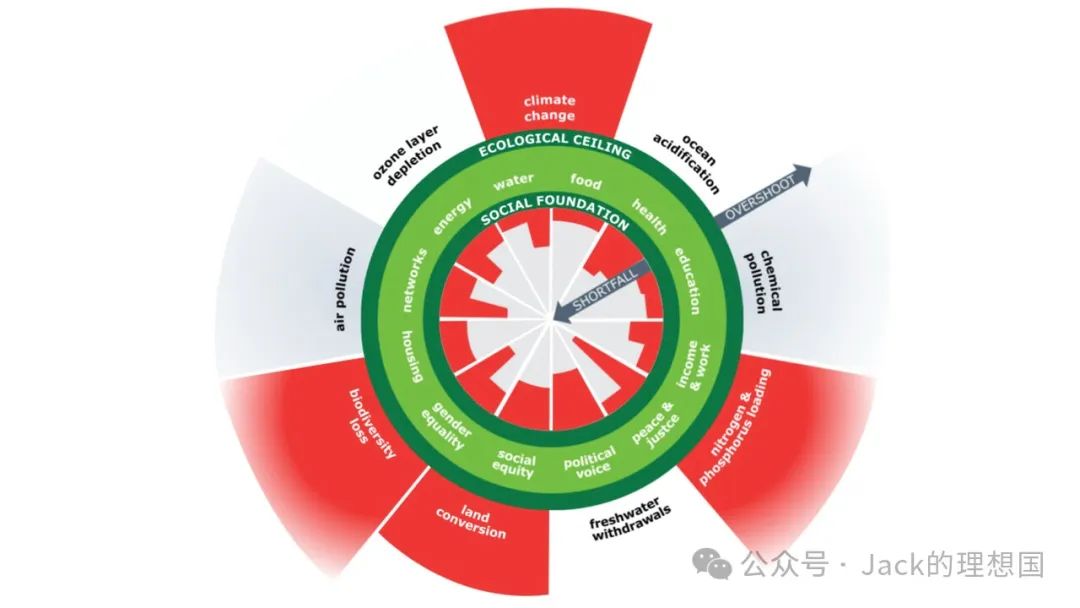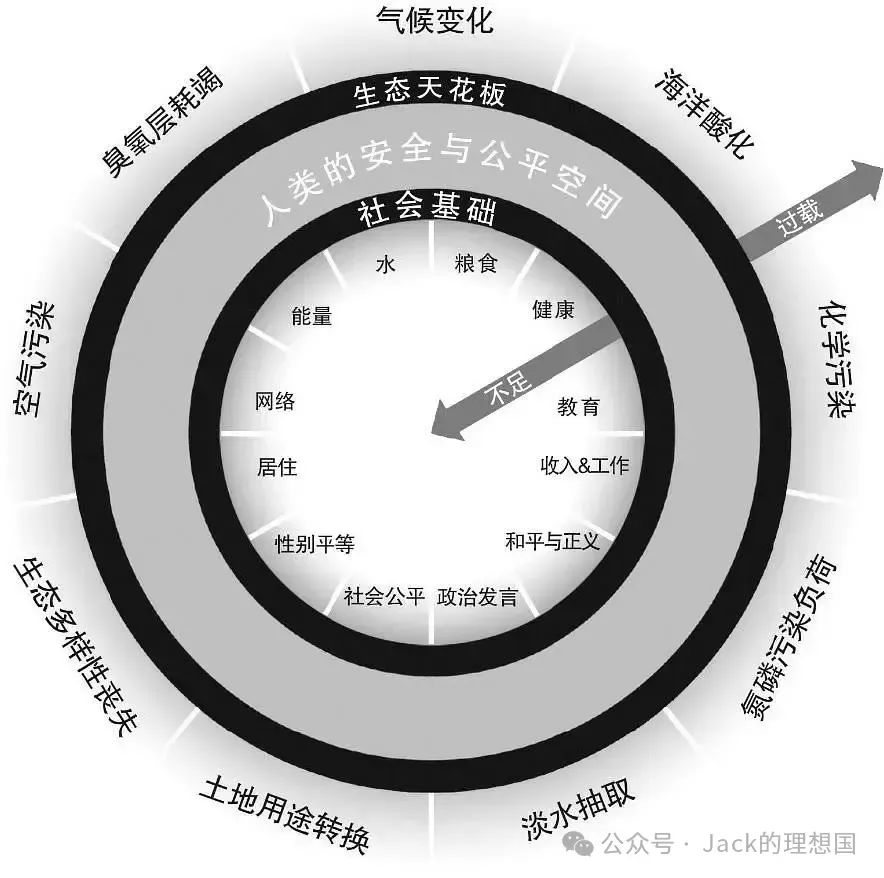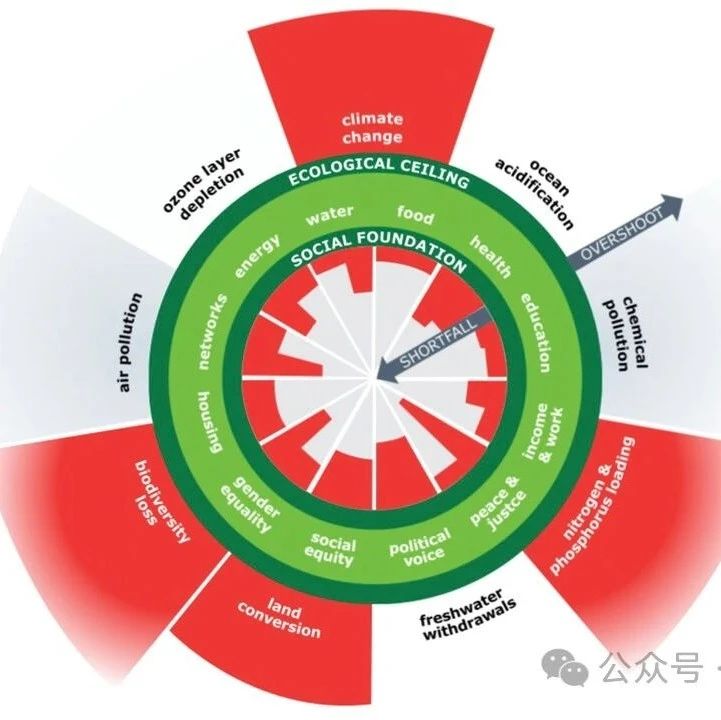Links Between East and West 54 Doughnut Economy 东西方的连接54 - 甜甜圈经济

In 2017, the economist Kate Raworth crafted a unique economic model called “The Doughnut Economic Model.” The model depicts the balance between environmental protection and social development that humankind in the 21st century must achieve. The model consists of two concentric circles. The outer circle is the “nine planetary boundaries,” including climate change, ocean acidification, and air pollution. Going beyond it brings unbearable environmental degradation. The inner circle is the “twelve dimensions of social foundation.” These include “peace and justice,” “food,” “health,” “energy,” and “education.” A spot in the circle means a “shortfall” to meet these crucial social standards. Between the social and planetary boundaries lies a goldilocks zone, an “environmentally safe” and “socially just space” for civilizations to sustainably progress.
There are many factors that determine where human civilization falls on the doughnut economic model. One of the most fundamental is technology. Technology can both aid and impede efforts to arrive in the goldilocks zone. Referencing the model, this essay will first broadly examine the relationship between technology, social foundation, and the natural environment in history. Then, the essay will discuss much needed actions for the current world to approach the goldilocks zone.
From the perspective of technology, history can be divided by several groundbreaking technological revolutions. The first is the Agricultural Revolution about 15,000 years ago. During the Agricultural Revolution, people developed many technologies and technological concepts to assist them in building a primary agricultural economy. For example, some European agricultural societies invented the slash and burn technique, an improvement to technology of controlling fire, to create open fields for crops. Communities also acquired the technological idea of animal domestication and selective breeding to provide vital nutrients and increase crop yield.
These agricultural technologies resulted in profound changes of human cultures and their relationship with the surrounding environment. During this formative period of history, people began to build and secure many of the social foundations of the doughnut model, such as “food,” or “housing.” However, while technological advancements did allow the early farmers to develop these social foundations, it was from this time that people began to approach the ecological ceilings. The aforementioned technologies already were detrimental to the natural environment. The slash and burn technique led to vast deforestation, and the domestication of many animals resulted in habitat loss and greenhouse gas production. As the shortfalls regarding social foundations narrowed, humans advanced closer to the ecological ceiling.
The primary agriculture economy lasted roughly until the Industrial Revolution in the 17th and 18th centuries. The Industrial Revolution witnessed the invention of technologies that changed the ways of production and consumption. Among these technologies, one of the most crucial is arguably the burning of fossil fuels. Through combustion, people gained the power to utilize the immense energy stored in the Earth.
Some impacts brought by the new technologies of the Industrial Revolution were quite comparable to those of the Agricultural Revolution. The technological advancements of the Industrial Revolution allowed the world to construct social foundations more systematically and efficiently. For example, as the Revolution picked up its pace, people discovered an ocean of energy sources, solving energy needs. The advent of mechanical production led to the birth of factories and companies that provided income and work to the populace. During the 18th and 19th centuries, societies witnessed continuous improvements in almost all the twelve dimensions of the inner circle of the doughnut economy.
However, technological development during the Industrial Revolution pushed societies gradually beyond the ecological ceiling. While societies gained greater stability and prosperity, the climate deteriorated and other issues such as biodiversity loss and freshwater withdrawals became increasingly glaring. As a result, as the world progresses on in the 21st century, there is an ever more urgent need to foster a sustainable economy that balances both social demands and the health of the environment.
The historical narrative above reveals a conundrum related to technology. There seemed to be an inevitable tradeoff between societal development and environmental conservation. The boons of solidifying social cornerstones can be offset by the deterioration of the natural environment. The opposite side of the relation might hold true as well. Today, as governments attempt to boost green technologies so that the world is pulled back under the ecological ceiling, some established social pillars might shake. For instance, the social foundations of “energy” rely heavily on non-renewable sources. As governments legislate non-renewables and subsidize renewables to move economies away from the former, this social foundation might be negatively impacted, as renewable energies, the supposed substitute, have not yet been employed on a massive scale. At least in the short run, there might be an energy shortage if governments insist on a total turn away from fossil fuels. The current world economy also depends on industries and sectors that require the burning of fossil fuels. Thus, bringing economies back to the ecological ceiling may entail significant economic tradeoffs for these industries.
In the past, the essence of this conundrum was that when new technologies appeared to advance social and economic well-being, the environment was the cost. Today, the center of this conundrum is that when countries focus sheerly on green technologies, some social cornerstones might become shaky and unstable. Moreover, while the world dreams of a clean future, states are not building the effective social foundations needed to embrace such a transition and a new green economy. Education inequality is still a formidable challenge, and health crises and wars are more frequent. Without these challenges being controlled, there would not be a stable future where the world enters the goldilocks zone of the doughnut model.
To refocus on constructing the twelve social dimensions proposed by Raworth, countries must more proactively embrace and utilize novel technology. Previously, in the times of the Agricultural and Industrial Revolutions, improvements in social foundations came as a benefit of technological progress. Now, there must be a greater intentional integration of technology into the development of fundamental social elements. Potential technological advancements are genuinely powerful. The world is at the cusp of another technological revolution defined by rapid developments in AI and virtual networks. Though some are highly skeptical of the powers of these technologies, if used in an effective way, they can help implement difficult plans to build social foundations. Governments should grasp this historical opportunity to convert the potential of technologies into tangible social progress.
Consider AI, a highly promising technology. Countries should actively employ and disseminate AI to improve social equity, one of the twelve dimensions of the doughnut model. For example, AI can potentially make healthcare more accessible and affordable. AI may work far more efficiently than a human to develop cost-effective solutions, such as telemedicine and diagnostics tools, that can help extend healthcare services to underserved populations. Using its more superior processing abilities, AI can also analyze large amounts of medical data to identify patterns and improve diagnostic accuracy, benefiting all individuals, especially those with limited access to healthcare.
Additionally, governments should apply AI tools to enhance access to education, another dimension of the doughnut model. Already, on educational platforms such as Khan Academy, AI-powered learning assistants provide personalized learning experiences to students. They may even be more competent teachers as they can adapt to students’ individual needs and abilities. If the government makes such AI learning tools more easily available, then it can bridge educational gaps and deliver a more equal opportunity for youngsters to receive quality education, regardless of their socioeconomic backgrounds.
The example of AI suggests that the world should attempt to unleash the immense potential of new technologies to build firmer social foundations. But AI is only one among the many technological inventions that have limitless potential. As social media networks and platforms evolve to be increasingly far-reaching and convenient, citizens globally should use them to spread initiatives, give voice to the voiceless, and call for cross-cultural communication. Virtual platforms can further be utilized to boost employment as they contain many job opportunities.
While this argument highlights the importance of social foundations, it does not necessarily mean that governments should terminate their efforts to transition into a green economy. Governments should still devote effort to share green technologies and leave markets open to foreign green products. Green protectionism will be the main hurdle to overcome as the world aims to re-contain humankind under the ecological ceiling. However, without an educated public, a more equitable and fluid society, the rapid change from an industrial to green economy would inflict significant harm on many groups. These groups are the ones that will struggle to make a living as the fossil fuel industry gets replaced. Such a crowding-out effect will especially be powerful in developing economies. Historically, as the example of China during the 1980s and 90s shows, without stable social foundations, shifts in the type of economy might lead to population displacement and reverberating consequences in the macroeconomy. Therefore, education and social equity are crucial for a socially efficient and sustainable shift to a new type of economy.
The focus of this essay is on the relationship between technology and the doughnut economic model. More specifically, it examined how technology positively or negatively affects where humankind stands in the model. In the first two groundbreaking technological revolutions, societies built and stabilized the twelve dimensions of social foundation with the aid of technologies, aiming to decrease a civilizational “shortfall” in meeting these demands. However, technologies born during these two revolutions pushed humankind beyond the ecological ceiling, leading to grave concerns about sustainability. As a result, today, governments constantly emphasize the importance of living sustainably under the ecological ceiling. They hope to remove the “overshoots” with green technologies. Unfortunately, such efforts have an opportunity cost that might lead to shortfalls in achieving the twelve social foundations. As a solution, this essay argued that states should not neglect the chance to proactively utilize the ongoing technological revolution to strengthen social foundations. Through this way, a steady transition to a green world is possible, where humans might reach the goldilocks zone.
Today is not a time for governments to “let go.” Many critics of government intervention in the economy, such as the Argentinian president Javier Milei, claim that government actions decrease the well-being of the public. This claim does not possess much merit in the context of the modern world. Currently, the government is the most indispensable institution to foster international cooperation in green energy and spearhead decision-making regarding AI. Without government intervention, markets may not be incentivized to the point where a safe transition to a green economy would be in time. Nor would it be wise to completely rely on the private sector to direct the use of technologies to build social foundations. The world is an era of great uncertainty and danger. But it is also an era of rare opportunities to define a new course for the development of humankind on this planet.

2017年,经济学家凯特-罗沃斯精心设计了一个独特的经济模型,名为 "甜甜圈经济模型"。该模型描绘了21世纪人类必须实现的环境保护与社会发展之间的平衡。该模型由两个同心圆组成。外圈是 "九大生态天花板",包括气候变化、海洋酸化与空气污染等,超越外圈将带来难以承受的环境恶化。内圈是 "社会基础的十二个方面",其中包括 "和平与正义"、"粮食"、"健康"、"能量 "和 "教育"等。内圈中的任意一点意味着在达到这些重要的社会标准方面存在 "不足"。在社会和生态边界之间有一个 "宜居带",这是一个 "环境安全 "与 "社会公正 "的空间,可供文明可持续发展。
有许多因素决定着人类文明在甜甜圈经济模型中的位置。其中最根本的因素是技术。技术既可以帮助人类进入 "宜居带",也可以阻碍人类进入 "宜居带"。本文将参考该模型,首先广泛考察历史上技术、社会基础与自然环境之间的关系。然后,文章将讨论当今世界亟需采取的行动,以接近 "宜居带"。
从技术的角度来看,历史可以被几场划时代的技术革命所划分。首先是大约 15000 年前的农业革命。在农业革命期间,人们发展了许多技术和技术概念,以帮助他们建立初级农业经济。例如,一些欧洲农业社会发明了刀耕火种技术,这是对控制火的技术的改进,目的是开辟农田种植庄稼。众多欧洲社区还掌握了动物驯化与选择性繁殖的技术概念,以提供重要的营养物质或提高作物产量。
这些农业技术使人类文化及其与周围环境的关系发生了深刻的变化。在这一历史形成时期,人们开始建立并确保甜甜圈模式的许多社会基础得以被保障,如 "食物 "或 "居住"。然而,尽管技术进步确实让早期农民发展了这些社会基础,但也正是从那时起,人们开始接近生态上限。上述技术已经对自然环境造成了破坏。刀耕火种技术导致大量森林被砍伐,许多动物的驯化导致栖息地的丧失和温室气体的产生。随着社会基础的不足逐渐缩小,人类的发展愈发靠近生态上限。
初级农业经济大致持续到 17 和 18 世纪的工业革命。工业革命见证了改变生产与消费方式的技术发明。在这些技术中,最关键的可以说是化石燃料的燃烧。通过燃烧,人们获得了利用地球中蕴藏的巨大能量的能力。
工业革命的新技术带来的一些影响与农业革命有很强的可比较性。工业革命的技术进步使世界能够更系统、更高效地构建社会基础。例如,随着革命步伐的加快,人们发现了能源之海,解决了能源需求。机械化生产的出现导致了工厂与私人公司的诞生,为人们提供了收入和工作。在 18 世纪和 19 世纪,社会见证了甜甜圈经济内圈几乎所有十二个方面的不断改进。
然而,工业革命期间的技术发展将社会逐渐推到了生态上限之外。在社会变得更加稳定与繁荣的同时,气候却在恶化,生物多样性丧失和淡水不足等其他问题也日益突出。因此,随着 21 世纪的到来,世界越来越迫切需要促进可持续经济的发展,以平衡社会需求和环境健康。
上述历史叙述揭示了一个与技术有关的难题,社会发展与环境保护之间似乎存在着不可避免的权衡。巩固社会基石所带来的好处可能会被自然环境的恶化所抵消。这种关系的反面也可能成立。今天,当各国政府试图推动绿色技术的发展,使世界回到生态上限之下时,一些既定的社会基础可能会发生动摇。例如,"能源 "的社会基础在很大程度上依赖于不可再生资源。随着各国政府对不可再生能源进行限制以及对可再生能源发放补贴,使经济脱离前者,这一社会基础可能会受到负面影响,因为可再生能源作为所谓的替代品,尚未得到大规模应用。至少在短期内,如果政府坚持完全放弃化石燃料,可能会出现能源短缺。当前的世界经济也依赖于需要燃烧化石燃料的行业与部门。因此,让经济停留在生态天花板之下可能会给这些行业带来巨大的经济损失。
过去,这一难题的本质是,当新技术出现以促进社会或经济福祉时,环境就是代价。如今,这一难题的核心在于,当各国单纯关注绿色技术时,一些社会基石可能会变得不稳定。此外,当全世界都梦想着一个清洁绿色的未来时,各国却没有建立起迎接这种转型与新的绿色经济所需的有效的社会基础。教育不平等仍然是一个严峻的挑战,健康危机和战争也更加频繁。如果这些挑战得不到控制,就不可能有一个稳定的未来,世界也就不可能进入甜甜圈模式的 "宜居带"。
要重新聚焦于构建罗沃斯提出的十二个社会基础方面,各国必须更加积极主动地拥抱并利用新技术。以前,在农业革命和工业革命时期,社会基础的改善是技术进步带来的自然好处。现在,人们必须更加有意识地将技术融入基本社会要素的发展。潜在的技术进步是真正强大的。世界正处于另一场技术革命的风口浪尖,这场革命由人工智能与虚拟网络的快速发展所定义。尽管有些人对这些技术的力量持高度怀疑态度,但如果以有效的方式加以利用,它们可以帮助实施建立社会基础的艰难计划。各国政府应抓住这一历史机遇,将技术潜力转化为实在的社会进步。
人们可以考虑人工智能这一极具潜力的技术。各国应积极采用、推广人工智能,以改善社会公平,这是甜甜圈模式的十二个社会基础之一。例如,人工智能有可能使医疗保健更方便、更实惠。人工智能可能比人类更有效地开发具有成本效益的解决方案,如远程医疗或诊断工具,帮助将医疗服务扩展到服务不足的人群。人工智能还能利用其更卓越的处理能力,分析大量医疗数据,找出模式并提高诊断准确性,从而惠及所有人,尤其是那些医疗服务有限的人。
此外,政府还应该应用人工智能工具来提高受教育的机会,这是甜甜圈模型的另一个社会基础。在可汗学院等教育平台上,人工智能驱动的学习助手已经为学生提供了个性化的学习体验。他们甚至可以成为更称职的教师,因为他们可以适应学生的个人需求和能力。如果政府能让这种人工智能学习工具更容易获得,那么就能缩小教育差距,为青少年提供更平等的接受优质教育的机会,而不论其社会经济背景如何。
人工智能的例子表明,世界应尝试释放新技术的巨大潜力,以建立更坚实的社会基础。但人工智能只是众多潜力无限的技术发明中的一种。随着社交媒体网络与平台发展得愈发广泛和便捷,全球公民应利用它们来传播倡议,为无声者发声,并呼吁跨文化交流。虚拟平台还可进一步用于促进就业,因为它们包含许多就业机会。
虽然这一论点强调了社会基础的重要性,但并不一定意味着政府应终止向绿色经济转型的努力。各国政府仍应努力分享绿色技术,并向外国绿色产品开放市场。绿色保护主义将是世界重新将人类控制在生态天花板之下需要克服的主要障碍。然而,如果没有一个受过教育的公众、一个更加公平与流动的社会,从工业经济到绿色经济的快速转变将对许多群体造成重大伤害。随着化石燃料产业被取代,这些群体将为生计而挣扎。这种挤出效应在发展中经济体尤为明显。从历史上看,正如上世纪八九十年代中国的例子所示,如果没有稳定的社会基础,经济类型的转变可能会导致人口迁移,并对宏观经济产生冲击。因此,教育与社会公平对于社会高效、可持续地向新型经济转型至关重要。
本文的重点是技术与甜甜圈经济模型之间的关系。更具体地说,它研究了技术如何对人类在该模型中所处的位置产生积极或消极的影响。在前两次划时代的技术革命中,社会借助技术建立并稳定了社会基础的十二个方面,旨在减少文明在满足这些需求方面的不足。然而,在这两次革命中诞生的技术将人类推到了生态天花板之外,引发了对可持续发展的严重担忧。因此,如今各国政府不断强调在生态上限下可持续生活的重要性。他们希望通过绿色技术来消除 "过冲"。遗憾的是,这种努力需要付出机会成本,可能会导致十二项社会基础无法持久地实现。作为一种解决方案,本文认为,各国不应忽视主动利用正在进行的技术革命来加强社会基础的机会。这样才有可能稳步过渡到绿色世界,人类才有可能达到 "宜居带"。
今天不是政府放手的时候。许多批评政府干预经济的人,如阿根廷总统哈维尔-米莱,声称政府行为会减少公众的福祉。在现代社会,这种说法值得商榷,目前,政府是促进绿色能源国际合作并引领人工智能决策的最不可或缺的机构。如果没有政府的干预,市场可能无法得到激励,从而无法及时安全地过渡到绿色经济。完全依靠私营部门来引导技术的使用以建立社会基础也不是明智之举。当今世界是一个充满不确定性与危险的时代,但这也是一个充满难得机遇的时代。如果做出正确且谨慎的选择,世界的国家可以为星球上人类的发展确定新的方向。
- 本文标签: 原创
- 本文链接: http://www.jack-utopia.cn//article/630
- 版权声明: 本文由Jack原创发布,转载请遵循《署名-非商业性使用-相同方式共享 4.0 国际 (CC BY-NC-SA 4.0)》许可协议授权










